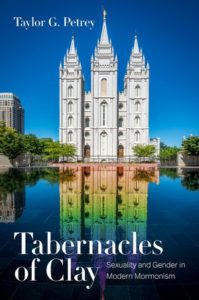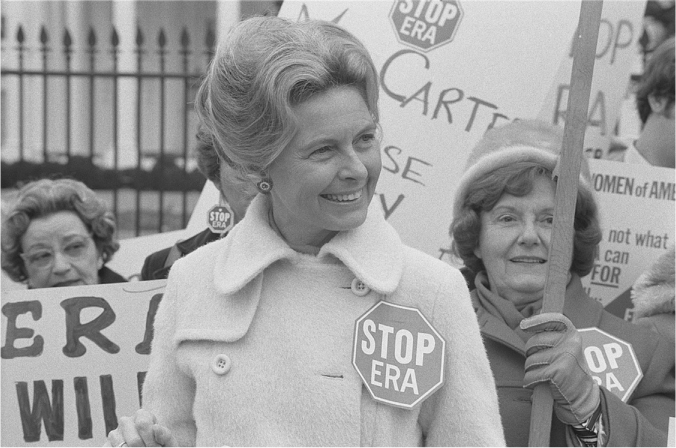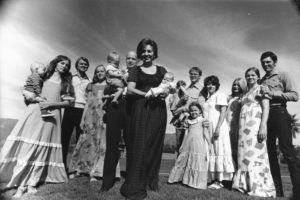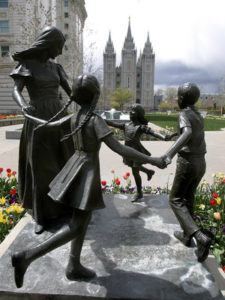Mormon Gender Politics and the Patriarchal Order
A book excerpt from Tabernacles of Clay: Sexuality and Gender in Modern Mormonism
The following excerpt comes from Taylor Petrey’s newest book Tabernacles of Clay: Sexuality and Gender in Modern Mormonism (Copyright © 2020 by the University of North Carolina Press. Used by permission of the publisher. www.uncpress.org). The book explores shifting Mormon perspectives on gender and sexuality from the post-WWII period through the present day.
This excerpt comes from the book’s third chapter, “Politics and the Patriarchal Order.”
***

 In November 1974, Catholic antifeminist activist Phyllis Schlafly booked a flight to Salt Lake City and secured a meeting with the newly appointed General President of the Relief Society, Barbara Bradshaw Smith (d. 2010). Smith had just been sustained in her new role over the church’s global women’s organization one month before the meeting. Schlafly was looking for new recruits in her battle against the Equal Rights Amendment, a proposed federal amendment that would ensure that men and women were treated equally by the law. At the time, Schlafly’s efforts to oppose the ERA seemed like a long-shot political strategy—it had the support of mainstream Republicans and Democrats and was steamrolling through the states. Mormons at the time also seemed unlikely to get involved—they rarely spoke on political matters and had not attempted to mass-mobilize their membership on specific political issues since Prohibition. Even more speculative was the idea that Mormons and Catholics would work side by side, since neither had a strong ecumenical record. Schlafly, however, was determined to build a broad coalition of conservative voices and to activate religious outsiders who did not think in political terms. In their meeting, Smith expressed some skepticism at first but warmed to the idea of getting the LDS church involved in the fight to oppose the ERA. After all, if the church taught that gender was at risk from changing sexual and cultural norms in secular society, shouldn’t its leaders act to protect it in the public sphere?
In November 1974, Catholic antifeminist activist Phyllis Schlafly booked a flight to Salt Lake City and secured a meeting with the newly appointed General President of the Relief Society, Barbara Bradshaw Smith (d. 2010). Smith had just been sustained in her new role over the church’s global women’s organization one month before the meeting. Schlafly was looking for new recruits in her battle against the Equal Rights Amendment, a proposed federal amendment that would ensure that men and women were treated equally by the law. At the time, Schlafly’s efforts to oppose the ERA seemed like a long-shot political strategy—it had the support of mainstream Republicans and Democrats and was steamrolling through the states. Mormons at the time also seemed unlikely to get involved—they rarely spoke on political matters and had not attempted to mass-mobilize their membership on specific political issues since Prohibition. Even more speculative was the idea that Mormons and Catholics would work side by side, since neither had a strong ecumenical record. Schlafly, however, was determined to build a broad coalition of conservative voices and to activate religious outsiders who did not think in political terms. In their meeting, Smith expressed some skepticism at first but warmed to the idea of getting the LDS church involved in the fight to oppose the ERA. After all, if the church taught that gender was at risk from changing sexual and cultural norms in secular society, shouldn’t its leaders act to protect it in the public sphere?
The meeting with Schlafly proved consequential. It marked an official beginning of the Mormon affiliation with the rising movement known as the Religious Right—a broad coalition of conservatives who felt alienated from the mainstream Republican Party and sought to make their voices heard through political action. Mormons had flirted around the edges of anti–civil rights activism in the 1950s and 1960s, but their leaders felt called in the 1970s on various fronts in the battle against feminism and homosexuality. In addition to preaching and a therapeutic outreach, Mormon leaders took on a political strategy that protected the church’s members and a broader culture from a sociology of gender fluidity. By focusing on the possibility that gender norms could change and positing that as a source of danger and a cause for fear rather than liberation, LDS political activism in the 1970s framed gender and sexuality as the province of government regulation.

Phyllis Schlafly in 1977 (Photo: Underwood Archives/UIG/Everett Collection)
Mormons did not exit this battle against the ERA in the same way that they entered. The politicization of Mormon teachings about gender left an unexpected mark on church teachings. The history of LDS political activism needs to be told from both the inside out and the outside in—how Mormon teachings influenced Mormons’ political actions and also how this political engagement shaped Mormon teachings. While most approaches to LDS politics discuss how Mormon doctrines inspired LDS activists’ efforts, this chapter also traces how LDS political activism redefined Mormon teachings. Specifically, Mormon antifeminist teachings and activism came to express moderate feminist ideals in the course of LDS activists’ political efforts. Emulating the rhetoric of segregationist political doctrines on race, at least some Mormons began to argue that male-female difference was not hierarchical but rather a “separate but equal” complementary difference. While opposing equal rights, Mormons nevertheless came to accept male-female equality as an ideal, however imperfectly. This tension, between the patriarchal order and soft egalitarianism, shot through this period as Mormon leaders struggled to articulate a doctrine for women in a changing era. This included significant transitions in how church leaders talked about the sexual relationship between husbands and wives and women’s paid labor outside the home.
The Patriarchal Order
Mormons were well positioned to join the politicization of the family in the 1970s. They had been eager participants in the postwar religious revival focused on the patriarchal home, and such values remained central to Mormon identity throughout this period. Many LDS women were attracted to this message and sought to counter feminism with a message of submission. They promised not only greater stability in the home and society but greater happiness for women than “women’s liberation” could offer. As discussed in an earlier chapter, Helen B. Andelin’s Fascinating Womanhood bred imitators and attracted proselytes. In the late 1960s in her local ward building in Arizona, Jacquie Davison had enrolled in a “Fascinating Womanhood” workshop led by Andelin and was inspired to start an organization to bring these ideas into the political sphere. Two years before Phyllis Schlafly’s STOP ERA, Davison founded the Happiness of Womanhood organization. It not only was dedicated to defeating the ERA but also opposed abortion, pornography, and homosexuality. The organization spread in Mormon-dominated areas of Utah, Arizona, and California, gaining ten thousand members in all fifty states by 1973. Davison saw in Andelin’s message a necessary turn to politics to sustain the patriarchal order.

Helen Andelin, author of Fascinating Womanhood, with her family
LDS church leaders continued previous warnings that gender segregation was necessary to prevent dangerous gender fluidity. Motherhood, to the exclusion of paid labor, was a special concern. Harold B. Lee, the conservative reformer of the Priesthood Correlation program, became president of the church from 1970 to 1973. In 1970, Correlation shut down the fifty-year-old Relief Society Magazine, and with it any independent venue for women and women’s leadership to write and publish according to their own editorial priorities. Lee’s stance on gender issues defined the church’s message. In 1972, he published an article in the new church magazine the Ensign titled “Maintain Your Place as a Woman.” Lee taught, “To be what God intended you to be as a woman depends on the way you think, believe, live, dress, and conduct yourselves as true examples of Latter-day Saint womanhood, examples of that for which you were created and made.” Womanhood was vulnerable to dissolution if it was not practiced. Among these practices, encouraged by Lee, were starting families without delay and having as many children as women were able. Lee warned of divine retribution for those who did not comply and blessings for those who did. If a married woman must work outside the home, she “should not neglect the cares and duties in the home.” He reprised the teachings about the patriarchal order of the family, explaining that “the wife is to obey the law of her husband only as he obeys the laws of God. . . . The good wife commandeth her husband in any equal matter by constantly obeying him.” Lee admonished that spousal submission and clear roles maintained boundaries between men and women. He believed that any weakening of these boundaries, even in seemingly trivial matters, might incur greater occurrences of lesbianism. “For a woman to adopt the mode of a man’s dress,” Lee warned, “is to encourage the wave of sexual perversion, when men adopt women’s tendencies and women become mannish in their desires.” Feminism and lesbianism were paired phenomena. Women should “maintain their place” against the cultural tides that undermined hierarchical sexual difference and ensured heterosexual desires.

A statue representing womanhood, and women’s role in raising children, with the LDS Temple in the background in Salt Lake City, Utah
Other church leaders in this period published similar antifeminist articles that defined women as essentially mothers. Like Lee, they warned especially against working women as a site of gender instability. Apostle Thomas S. Monson (d. 2018) complained in an article titled “The Women’s Liberation Movement: Liberation or Deception?” that some women were demanding “free abortion, free childcare, and equal employment.” Monson believed that these women were abandoning their divinely ordered responsibilities. He emphasized that “every woman is endowed by God with distinctive characteristics, gifts, and talents, in order that she may fulfill a specific mission in the eternal plan,” namely, motherhood. Another senior church leader warned, “One of the greatest tragedies of our day is the confusion of minds of some which would cause mothers to go to work in the marketplace.” Another apostle explained that women’s liberation and the sexual revolution are “Satan’s way of destroying women, the home, and the family.” Working women not only were unfaithful and disobedient and at risk of lesbianism but also advanced satanic purposes.
Taylor Petrey is an Associate Professor of Religion at Kalamazoo College and Editor of Dialogue: A Journal of Mormon Thought.
***
Interested in more on this topic? Check out episode 11 of the Revealer podcast: “Mormons and Changing Ideas about Gender and Sexuality” with Taylor Petrey.